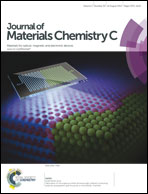Highly efficient orange and deep-red organic light emitting diodes with long operational lifetimes using carbazole–quinoline based bipolar host materials†
Abstract
Orange and deep red-emitting phosphorescent organic light-emitting diodes (PhOLEDs) are important for OLED displays and lighting; however, high-performance with long operational lifetime hosts designed for orange/deep red PhOLEDs are very rare. Three new carbazole–quinoline hybrids are synthesized and used as the host materials for orange and deep-red PhOLEDs. These bipolar hosts show high glass transition temperatures of 90–146 °C and triplet energy gaps of 2.51–2.95 eV. The optimized orange PhOLEDs using 9-(4-(4-phenylquinolin-2-yl)phenyl)-9H-carbazole (CzPPQ) as the host show the highest external quantum efficiency (EQE) of 25.6% and a power efficiency of 68.1 lm W−1, which are the highest values for orange PhOLEDs. More importantly, the efficiency roll-off is extremely small for both the orange and deep-red devices. For example, an orange device showed an EQE of 25.1% at 100 cd m−2 and 23.6% at 1000 cd m−2; the result appears to be the lowest efficiency roll-off for orange PhOLEDs to date. Additionally, the operational lifetime of both the orange and deep-red devices gave a T50 of more than 26 412 and 11 450 h, respectively, at an initial luminance of 500 cd m−2. The values are 12 times (orange) and 6 times (red) longer than those of the corresponding devices using CBP as the host.


 Please wait while we load your content...
Please wait while we load your content...